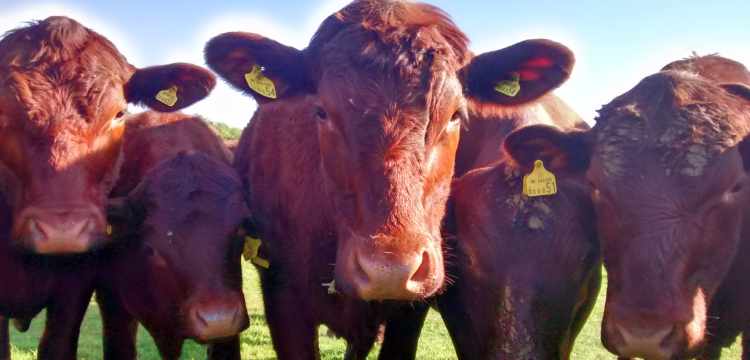 The Red Poll is East Anglia’s native breed, a cross between a Suffolk polled (hornless) bull and a Norfolk cow (both now extinct), and was first described as a breed in the latter half of the Nineteenth Century. In the early Twentieth Century it was one of the dominant breeds in English dairy farming. The breed is truly dual purpose, producing excellent tasting beef, and a good yield of milk with a high butterfat and protein content. We don’t milk though; that’s left to the calves. There’s more information about the breed at Red Poll Cattle Society
The Red Poll is East Anglia’s native breed, a cross between a Suffolk polled (hornless) bull and a Norfolk cow (both now extinct), and was first described as a breed in the latter half of the Nineteenth Century. In the early Twentieth Century it was one of the dominant breeds in English dairy farming. The breed is truly dual purpose, producing excellent tasting beef, and a good yield of milk with a high butterfat and protein content. We don’t milk though; that’s left to the calves. There’s more information about the breed at Red Poll Cattle Society
Watch cattle grazing
Here’s a video of a couple of our cattle in high summer – worth a look especially if you’re viewing this in winter, just to remind you of a summer evening…
Why we chose Red Poll Cattle
When we decided to buy cattle, we spent a long time talking to people, reading and thinking about which breed to keep. We knew that our land and to some extent our characters were suited to an old fashioned native breed so we didn’t spend much time considering modern continentals.
When asked, we found that most cattle people swear that their favoured breed produces the best beef on the poorest forage, is the easiest calver, is the friendliest, best at crosswords, etc. When it came down to it we liked the idea of a local breed and as we are just about in East Anglia, the choice was suddenly limited. But what really made the decision easy was an introduction to a couple in a neighbouring village who have kept Red Polls for a while. Their enthusiasm and generosity caught us; the taste of the beef sealed the decision.
Red Poll cattle make excellent mothers – here’s proof…
Of course Red Polls have proved to be easy calvers and excellent mothers, producing plentiful milk throughout an eight month lactation. They seem to cope happily with adverse weather and relatively poor feed and they are on the whole pretty docile although we have a couple of characters who need to be treated with respect. We bought our first three in-calf cows in 2003 and have since grown very fond of them… ..and they produce fantastic beef. Read more about our beef and how to buy it..
Neospora caninum
Closure of a permissive path (12 February 2017)
Neospora is a protozoan parasite that requires both cattle and dogs to complete its life cycle. The dog eats placental or foetal material infected with the protozoan, it then sheds oocysts (the eggs) in its poo which persist in the environment for a long time. Cattle then graze an area where the dog poo has left oocysts and the cycle continues. The cow then has an increased risk of abortion and will pass the parasite through the placenta to her unborn calf.
Our understanding from the vet is that this parasite has an extremely rare chance of causing problems in dogs and has no ill effects in humans. Worming dogs has no effect on the Neospora parasite.
We have identified Neospora as a problem on our farm from blood tests following abortions in our herd.
What can we do? There is no vaccine or cure but we can follow our vet’s advice to keep dogs away from any calving areas. This will help break the parasite’s life cycle. On the farm this means we have closed a permissive path that crosses the field where calving takes place. This runs from Campton Road, opposite Town Farm Garage, to the old pub corner.
However, we cannot control what comes in from outside the farm. The other advice is to keep all feed, grass, and hay free from dog faeces. This is very difficult with all the footpaths across the farm, but as much as we can, we will continue to encourage dog owners to pick up after their dogs.
